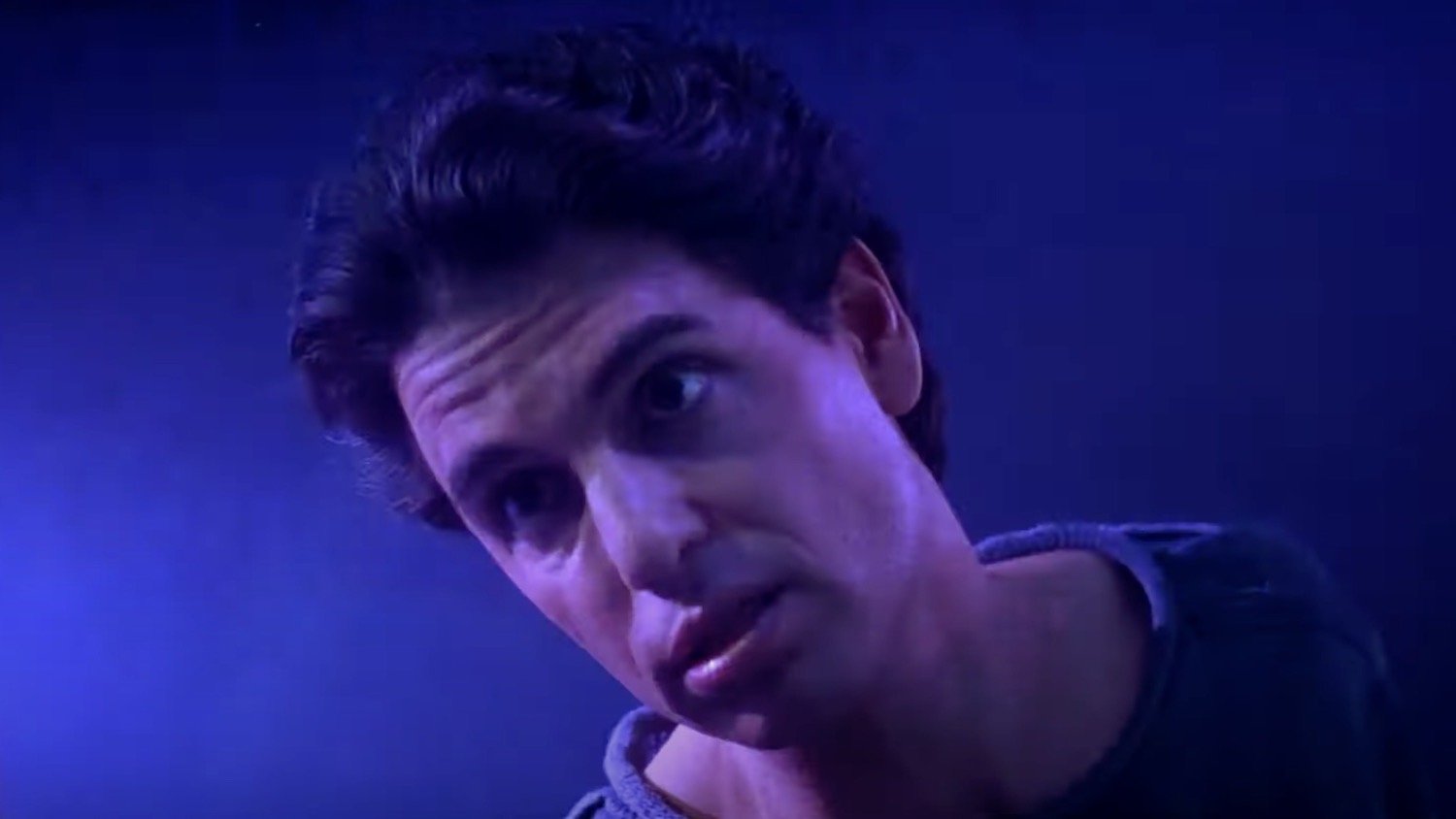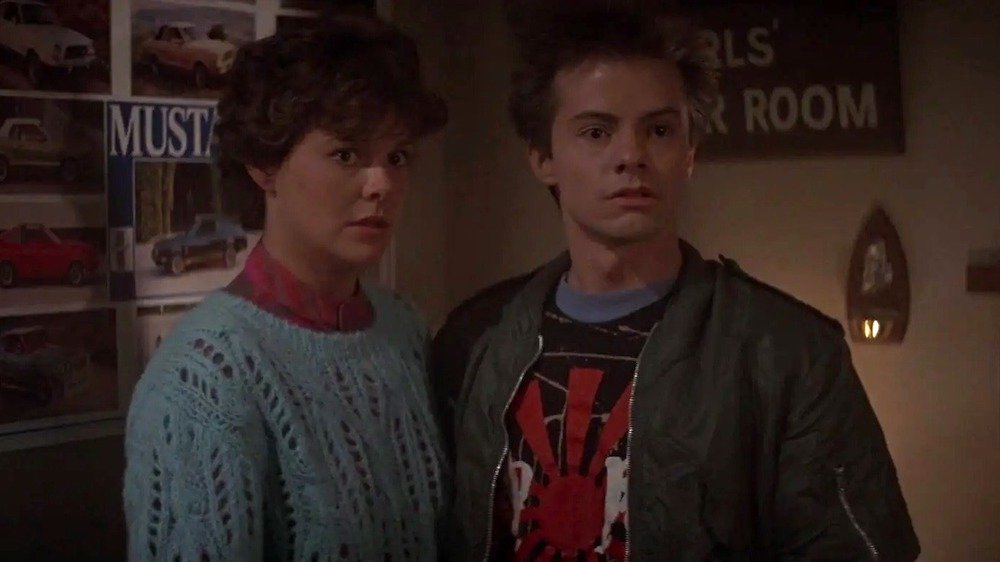Investigating ‘Fright Night’ and The Vampire Next Door
Comedy horror was on a roll in the mid-1980s, as the summer of 1984 served up Ghostbusters and Gremlins — on the same day, no less — and the summer of 1985 brought Fright Night. The movie hit theaters on August 2nd, so today is the anniversary of when it first introduced viewers to suburban teen Charley Brewster and his vampire next-door neighbor, Jerry Dandridge, played by the other Sarandon, Chris (two years after Susan in “The Hunger”).
Earlier films like The Fearless Vampire Killers had already tested the genre’s comedic possibilities, so Fright Night wasn’t the first vampire comedy, and it certainly wouldn’t be the last. But it happens to be one of the best, and this is one vampire popcorn flick that’s rife with interesting subtext.
When Fright Night turned 35 two summers ago, writer-director Tom Holland, who also gave the killer doll Chucky his debut in Child’s Play, said in a podcast interview, “I was looking for subtext everywhere.” One subtext he found was unapologetically queer, though audiences at the time didn’t pick up on it as well as modern viewers do. For Holland, who was surrounded by gay friends, this subtext was born out of the burgeoning AIDS crisis.
“It Wiped Out an Entire Generation”
If you’ll permit me front-loading a lengthy quote straight from the horse’s mouth, Tom Holland (not to be confused with the Spider-Man actor) told Consequence of Sound:
“I’ve always admired and loved gay society in Hollywood. It taught me a lot, really, aesthetically. Because if you’re working in the business, at least then — I’m sure still now — there were a lot of gay people around. Back then, it was sort of sub rosa. But in 1979 or ‘80, the first gay friend of mine died. And then it picked up, the number of deaths. Nobody knew what was going on. I certainly didn’t. And it seemed like a time to try to help people, whatever the hell was going on.”
Story continues below
Holland continued:
“Now, the difference between ’84 and ’87, I think when I made Child’s Play … by ’87, they had the AIDS blanket going. And by ’87, it had a name. The plague that came out, it was called AIDS. But in 1984, I don’t remember anybody having given it a name yet. Now, maybe I’m wrong because I was working so hard, I was probably not plugged into the news as well as I should be. But I was trying to be sympathetic towards the plight of homosexuals. I mean, love is love. Straight or gay. So, there you go.
“That’s how I felt at the time, but by the time I got to doing Child’s Play, it had turned into a full-on [epidemic]. I counted it up in the early ’90s, and I had lost 18 friends or close associates with work. I’d lost 18 of them to AIDS. It wiped out an entire generation. If you didn’t live it, you don’t know the destruction that took place in this town, in Hollywood.”
“You’re So Cool [and Queer], Brewster”
In his efforts to make a gay-friendly vampire film, Holland enlisted more than one LGBTQ cast member for Fright Night. The first face we see is that of Roddy McDowall, who appears on a TV screen as Peter Vincent the Vampire Killer. McDowall never came out while he was alive, but multiple biographies of Montgomery Clift (A Place in the Sun, From Here to Eternity) have linked the two men in a romantic relationship. Turner Classic Movies now lists McDowall as an LGBT icon.
As for Charley Brewster (William Ragsdale), when we first meet him in Fright Night, he's making out with his girlfriend, Amy, in his bedroom. Amanda Bearse plays Amy; she would come out as a lesbian in 1993 while costarring in Fox’s Married... with Children.
When he sees a vampire moving in next door, Charley, too, loses interest in the opposite sex, ignoring Amy and looking out the window through his binoculars as she disrobes on his bed. “You’ll never believe this,” he tells her. “There are two guys out there, carrying a coffin.”
Story continues below
Against the backdrop of the AIDS crisis, two guys carrying a coffin seems like a loaded visual metaphor. One of the guys is Jerry’s live-in male carpenter, Billy Cole (Jonathan Stark), who tells the police he’s Jerry’s roommate. Even Charley’s mom senses, “My luck, he’s probably gay.”
As a familiar, Billy is so familiar with Jerry, in fact, that we see him kneeling at his crotch. There are also double entendres like, “He’ll be able to suck his way through the entire town,” plus this dialogue between Charley and his friend Evil Ed:
EVIL ED: Where and when do you expect the vampire to attack?
CHARLEY: In my bedroom. Tonight.
Stephen Geoffreys, the actor who plays Evil Ed, went on to appear in gay porn using the stage name Sam Ritter. Maybe that’s why Ed, despite laughing about prostitutes being decapitated, doesn’t like being called Evil. Yet he’s all too ready to label Charley a “fruitcake” —a word sometimes applied in a derogatory manner to homosexual men.
“Infectious Behavior”
Charley isn’t just paranoid in Fright Night, as Jerry does attack him in his bedroom. Since a vampire, as Evil Ed observes, “cannot enter your house without being invited by the rightful owner first,” Charley has his mom to thank for Jerry’s intrusion. The vampire literally comes out of the closet to get him, then throws him back through the door into that same closet.
As Jerry further overpowers him, Charley accidentally knocks a framed photo of Amy out the window, thereby impaling his girlfriend’s face (and heteronormative codes of conduct) on the white picket fence.
Peter Vincent regards Charley as delusional about vampires and talks of “curing” him, but Jerry is more accepting of Evil Ed, telling him, “You don’t have to be afraid of me. I know what it’s like being different.” This line comes after he’s followed Evil Ed down a dark alley, as if he were a nightwalker as much in the street hooker sense as the vampire sense.
Story continues below
Note how Jerry bites Amy in a nightclub, another place where a person could meet a one-night stand and potentially acquire HIV during the AIDS crisis. As if to telegraph it, the song that plays while they’re on the dance floor, Ian Hunter’s “Good Man in a Bad Time,” even has lyrics about “infectious behavior.”
It’s implied that Amy is Jerry’s long-lost love reincarnated, the way Mina Harker would be for the Count in Bram Stoker’s Dracula. This codes him as bisexual, but either way, he, Billy, and Evil Ed all suffer the same fate. At least Peter Vincent shows some pity for Ed during his agonizing, wolfed-out death scene.
Coming Out of the Coffin
In films like Fright Night and Interview with the Vampire, vampires can and have been used as a workable metaphor for queer identity. You can even see this in the 2004 Salem’s Lot TV miniseries, with its gay teacher, Matt Burke (Andre Braugher), and its live-in business partners, Kurt Barlow (Rutger Hauer) and Richard Straker (Donald Sutherland).
The only problem is, the metaphor starts to break down when you have the vampires killing people, as if being queer were as bad as murder. As Buzzfeed points out, this is where Showtime’s True Blood ran into trouble: by trying to make vamps a civil rights metaphor. Creator Alan Ball is quoted as saying:
“To look at these vampires on the show as metaphors for gays and lesbians is so simple and so easy, that it's kind of lazy. If you get really serious about it, well, then the show could be seen to be very homophobic because vampires are dangerous: They kill, they're amoral.”
Story continues below
Ball and the makers of True Blood, however, leaned into the metaphor with phrases like “coming out of the coffin” and “God hates fangs,” so you can’t fault the viewer for making the connection between vampires and LGBTQ people.
In the end, the two communities — one fictional and fanged, the other real and very much decimated by the AIDS crisis — clearly don’t offer a perfect one-to-one comparison. Under the guise of a simple vampire comedy, however, Fright Night nevertheless leaves the viewer with some food for thought when it comes to being “different” and surviving in hostile times, be it the mid-1980s or the here and now.








